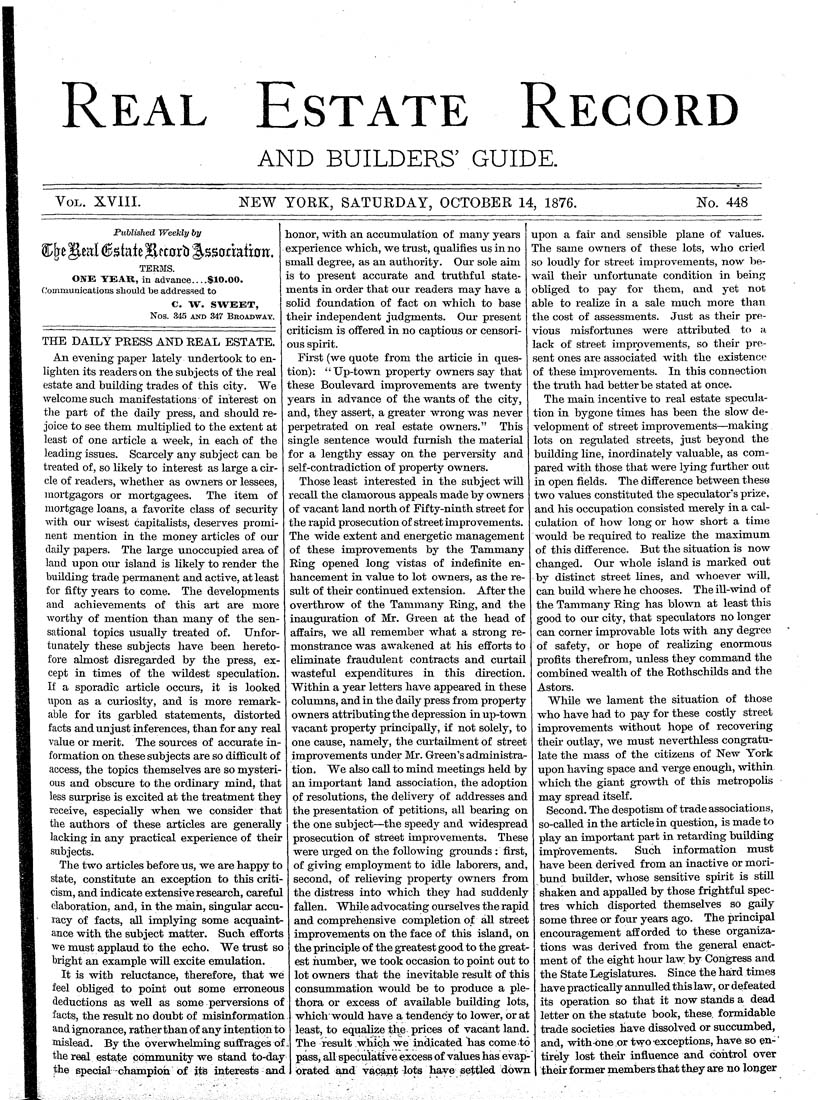Columbia University Libraries Digital Collections: The Real Estate Record
Use your browser's Print function to print these pages.
Real estate record and builders' guide: v. 18, no. 448: October 14, 1876

Text version:
Please note: this text may be incomplete. For more information about this OCR, view About OCR text.
Real Estate Record AND BUILDERS' GUIDE. Vol. XVIII. NEW YORK, SATURDAY, OCTOBER 14, 1876. No. 448 Published Weekly by E^t ged (Estate Retort) %%%atmiian. TERMS. ONE YEAR, in advance.., .$10.00. Communications should be addressed to C. W. SWEET, Nos. 345 AND 347 Broadway. THE DAILY PRESS AND REAL ESTATE. An evening pai)er lately undertook to en¬ lighten its readers on the subjects of the real estate and buUding trades of this city. We welcome such manifestations of interest on tlie part of the daily press, and should re¬ joice to see them multiplied to the extent at least of one article a week, in each of the leading issues. Scarcely any subject can be treated of, so likely to interest as large a cir¬ cle of readers, whether as owners or lessees, mortgagors or mortgagees. The item of mortgage loans, a favorite class of security with our wisest capitalists, deserves promi¬ nent mention in the money articles of our daUy papers. The large unoccupied area of land upon our island is likely to render the building trade permanent and active, at least for fifty years to come. The developments and achievements of this art are more worthy of mention than many of the sen¬ sational topics usually treated of. Unfor¬ tunately these subjects have been hereto¬ fore almost disregarded by the press, ex¬ cept in times of the wildest speculation. If a sporadic article occurs, it is looked upon as a curiosity, and is more remark¬ able for its garbled statements, distorted facts and unjust inferences, than for any real value or merit. The sources of accurate in¬ formation on these subjects are so diflS.cult of access, the topics themselves are so mysteri¬ ous and obscure to the ordinary mind, that less surprise is excited at the treatment they receive, especially when we consider that the authors of these articles are generaUy lacking in any practical experience of their subjects. The two articles before us, we are happy to state, constitute an exception to this criti¬ cism, and indicate extensive research, careful elaboration, and, in the main, singular accu¬ racy of facts, aU implying some acquaint¬ ance with the subject matter. Such efforts we must applaud tb the echo. We trust so bright an example will excite emulation. It is with reluctance, therefore, that we feel obliged to point out some erroneous deductions as well as some perversions of facts, the result no doubt of misinformation aud ignorance, rather than of any intention to mislead. By the overwhelming suffrages of the real estate community we stand to-day the special champioh of its interests and honor, w^ith an accumulation of many years experience which, we trust, qualifies us in no small degree, as an authority. Our sole aim is to present accurate and truthful state¬ ments in order that our readers may have a solid foundation of fact on whicli to base their independent judgments. Om- present criticism is offered in no captious or censori¬ ous spirit. First (we quote from the article in ques¬ tion): "Up-town property owners say that these Boulevard improvements are twenty years in advance of the wants of the city, and, they assert, a greater wrong was never perpetrated on real estate owners." This single sentence would furnish the material for a lengthy essay on the perversity and self-contradiction of property owners. Those least interested in the subject will recall the clamorous appeals made by owners of vacant land north of Fifty-ninth street for the rapid prosecution of street improvements. The wide extent and energetic management of these improvements by the Tammany Ring opened long vistas of indefinite en¬ hancement in value to lot owners, as the re¬ sult of their continued extension. After the overthrow of the Tammany Ring, and the inauguration of Mr. Green at the head of affairs, we all remember what a strong re¬ monstrance was awakened at his efforts to eliminate fraudulent contracts and curtail wasteful expenditures in this direction. Within a year letters have appeared in these columns, and in the daily press from property owners attributing the depression inup-town vacant property principaUy, if not solely, to one cause, namely, the curtailment of street improvements under Mr. Gi-een's administra¬ tion. We also call to mind meetings held by an important land association, the adoption pf resolutions, the delivery of addresses and the presentation of petitions, all bearing on the one subject—^the speedy and widespread prosecution of street improvements. These were urged on the foUowing grounds : first, of giving employment to idle laborers, and, second, of reUeving propei'ty owners from the distress into which they had suddenly fallen. A¥hile advocating ourselves the rapid and comprehensive completion of aU street improvements on the face of this island, on the principle of the greatest good to the great¬ est number, we took occasion to point out to lot owners that the inevitable result of this consummation would be to produce a ple¬ thora or excess of avaUable building lots, which'would have a tendency to lower, or at least, to equalize the prices of vacant land. The result which we indicated has come to pass, aU speculative excess of values has evap¬ orated and vacant lots have settled down upon a fair and sensible plane of values. The same owners of these lots, who cried so loudly for street improvements, now be¬ wail their unfortunate condition in being obliged to pay for them, and yet not able to realize in a sale much more than the cost of assessments. Just as their pre¬ vious misfortunes were attributed to